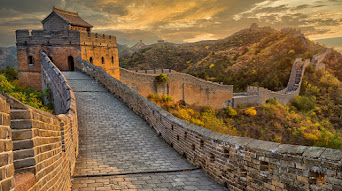The 7 Wonders of the World
- Greater China Wall (China)
The Great Wall of China is a stone and earth wall that was constructed between the fifth and sixteenth centuries B.C. to defend the Chinese Empire's frontiers from invading Mongols. The Great Wall, the longest man-made structure in the world, is actually a series of several barriers that spans around 4,000 kilometers.
- Statue of Christ the Redeemer (Rio de Janeiro)
Since 1931, the Christ the Redeemer statue in the Art Deco style has watched majestically over the Brazilian people from atop Corcovado mountain. Heitor da Silva Costa created the 130-foot reinforced concrete and soapstone statue, which was built for about $250,000, most of which was donated through contributions. The monument is now a well-known symbol of Rio and Brazil
- Máximo Picchu (Peru)
Scholars believe that the adjacent Incan capital of Cusco's surrounding sacred archaeological center was located at Machu Picchu, an Incan metropolis of dazzling granite poised perilously between two towering Andean peaks. This mountain stronghold was constructed in the middle of the fourteenth century during the height of the Incan Empire and was later abandoned. Before 1911, when archaeologist Hiram Bingham unearthed the site, it was only known to locals. Only foot, train, or helicopter access is available to the monument; the majority of visitors arrive by train from neighboring Cusco.
- Chinese Itza (Yucatan Peninsula, Mexico)
The magnificent ruins of Chichen Itza are a prime example of the brilliance and flexibility of Mayan culture. The Mayan civilization's political and economic capital, this mighty city thrived from roughly 800 to 1200 and served as a trading hub for fabric, slaves, honey, and salt. The site's El Caracol ruin, a sophisticated astronomical observatory, is the most well-known ruin there.
- The Colosseum of Rome (Rome)
Without a question, Rome's Colosseum is Italy's or Rome's most enduring emblem. It was created between the years of 70 and 80 AD and used for almost 500 years. Nearly 50,000 spectators watched the gladiatorial contests as well as other public spectacles including battle reenactments, animal hunts, and executions from the elliptical structure's seats. The Colosseum is now in ruins due to earthquakes and stone thieves, but some of the building's interior is still accessible to tourists, and even after 2,000 years, the Colosseum's design continues to be used in the creation of current amphitheaters.
- A Taj Mahal (Agra, India)
The Taj Mahal, a mausoleum commissioned for Shah Jahan's wife, was constructed between 1632 and 1648. The white marble building, which is regarded as the finest example of Muslim art in all of India, combines Persian, Islamic, Turkish, and Indian architectural elements. The Taj Mahal is surrounded by classic grounds with raised walkways, recessed flowerbeds, and a pool with a straight reflection.
- Petra (Jordan)
Petra, which was named a World Heritage Site in 1985, served as the seat of King Aretas IV's Nabataean empire and most likely existed during its height between 9 B.C. and 40 A.D. They built complex tunnel systems and water chambers that helped create a faux-oasis, demonstrating that they were early masters of water technology. A multitude of amazing stone carvings, a 4,000-seat amphitheater, and the El-Deir monastery have all contributed to the site's notoriety.
THANK YOU FOR READING



.jpg)
.jpg)
.jpg)
.jpg)
.webp)
.jpg)




0 Comments